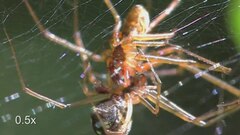Common canopy spider
| Common canopy spider | ||||||||||||
|---|---|---|---|---|---|---|---|---|---|---|---|---|

Linyphia triangularis (female) |
||||||||||||
| Systematics | ||||||||||||
|
||||||||||||
| Scientific name | ||||||||||||
| Linyphia triangularis | ||||||||||||
| ( Clerck , 1757) |
The common canopy spider ( Linyphia triangularis ) is a species of spider from the family of canopy spiders (Linyphiidae). In contrast to many other members of the family, this species is easy to identify due to its striking drawing on the front body. The common canopy spider is one of the most common canopy spiders in Central Europe. She was the European Spider of the Year 2014.
features
The species is one of the larger canopy spiders. Both sexes are about the same length, the body length is about 5–7 mm. The basic color of the front body ( prosoma ) of the females is a light beige-brown. The prosoma has a broad black-brown border and has a black central band that divides towards the front in the middle of the prosoma and ends in front of the eyes. This drawing is reminiscent of a tuning fork .
The abdomen ( opisthosoma ) has a broad, brown and mostly dark-edged central band on a yellowish white background, which is constricted several times. In individuals with strong constrictions, almost triangular spots develop, which led to the naming of the species ( Tres maculae fubrubrae, triangulares fere, ... ). The sides of the back of the body also show a drawing of broad, somewhat torn brown bands and spots. The underside is black. The legs are solid beige-brown.
As with most spiders, males have a significantly narrower rear body than females. The basic color is more red-brown. They also have greatly elongated chelicerae .
distribution and habitat
The common canopy spider inhabits large parts of the Palearctic from Ireland and the Canary Islands to northeast China. The distribution area includes the temperate to subtropical zones. Except for Iceland, it occurs all over Europe.
The species is not very specialized in terms of its habitat and does not inhabit forests that are too moist and open areas of all kinds, including parks and gardens.
Way of life
The net is usually laid low above the ground, but also up to several meters above the ground in grasses, perennials and shrubs. As with most members of the family, it consists of a horizontal net carpet stretched downwards, over which an approx. 20 cm high network of very loose "stumbling threads" is laid. The spider almost always sits on its back on the underside of the net carpet. The prey usually hits the stumbling blocks and then falls onto the net carpet, where it is captured by the spider.
Sexually mature animals occur from August to October. Mating takes place in Central Europe mainly in September. At this time, the males are constantly in the females' net. For copulation, the male also sits on his back in front of the female and alternately introduces his pedipalps into the sexual opening ( epigyne ) of the female. It then fills up its pedipalps from its sperm network created in the female's net and is then ready to mate again.
Danger
The species is very common in all suitable habitats. In Germany it is classified as "safe" in the Red List .
literature
- Heiko Bellmann : Cosmos Atlas Arachnids of Europe . 3rd edition, 2006. Kosmos, Stuttgart, ISBN 978-3-440-10746-1 .
- Ralph Platen, Bodo von Broen, Andreas Herrmann, Ulrich M. Ratschker, Peter Sacher: Total species list and red list of spiders, harvestmen and pseudoscorpions of the state of Brandenburg (Arachnida: Araneae, Opiliones, Pseudoscorpiones) with information on frequency and ecology. Nature conservation and landscape management in Brandenburg 8, booklet 2 (supplement); 1999.
Web links
Common canopy spider in the World Spider Catalog
Individual evidence
- ↑ European Society of Arachnology: European Spider of the Year 2014. ( Memento of the original from March 15, 2014 in the Internet Archive ) Info: The archive link was inserted automatically and has not yet been checked. Please check the original and archive link according to the instructions and then remove this notice. Retrieved March 15, 2014.
- ↑ Michael J. Roberts : Spiders of Britain and Northern Europe . 1st edition. Collins Field Guide, 1996, ISBN 0-00-219981-5 (Over 450 Species).
- ^ Carl Alexander Clerck : Svenska Spindlar . 1757 (first description of the species, pp. 71–73).
- ^ Map of the worldwide distribution of the common canopy spider from the British Arachnological Society



